
Catching the swarm
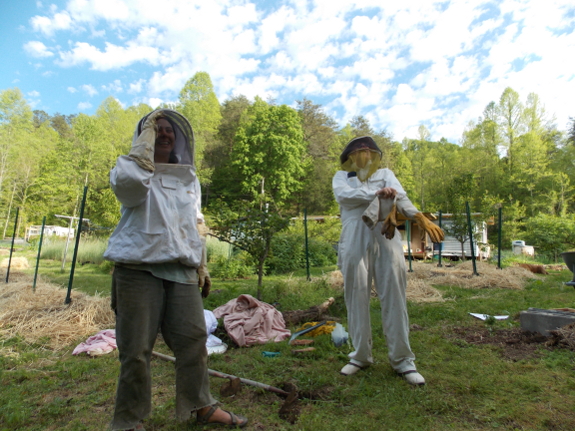
"Our hive cast
a swarm!! The
first one ever!! What do I do?"
Perhaps it was the
excess of exclamation points, but something told our
movie-star neighbor he should skip the advice and just come over to
lead the capture.
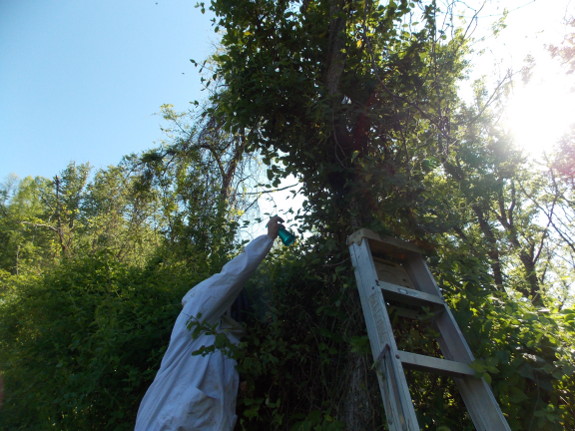
Our neighbor later told
us that this was the toughest swarm he'd ever
captured because of the masses of honeysuckle encircling the
bees. Mark had suggested we cut away the vines, but I was
terrified this swarm would be annoyed by the activity and leave just
like last year's package did. Luckily, our neighbor had a simple
solution --- spray the swarm liberally with sugar water so they'd stay
put, then clip those vines.
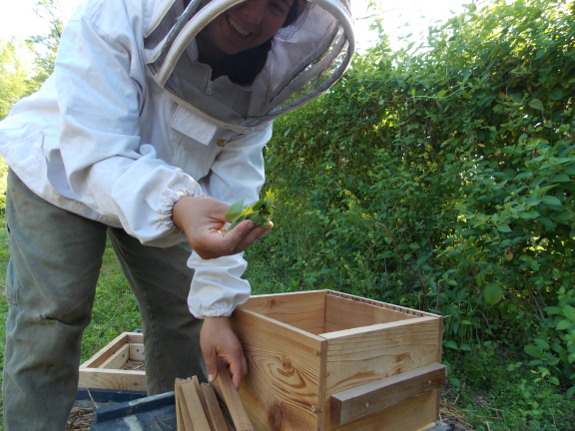
He also suggested we
smear peach leaves along the inside of the boxes
we were going to install the honeybees into. Since our neighbor
had just
bought some lemongrass oil on my recommendation, we also dabbed a few
drops of that fragrant substance on the inner walls of the hive as well.
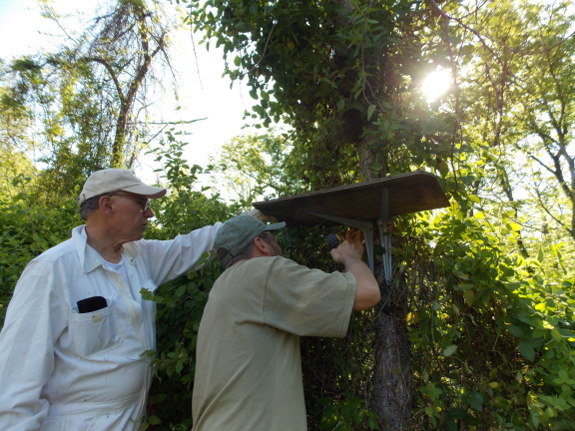
"Are we going to scoop
the bees into a bucket?" I asked. (Imagine
this sentence uttered with the intonation of the classic "Are we there
yet?") We'd very carefully cut all of the vines underneath the
swarm, but left one in the middle to make the mass of bees easy to
shake. But into what?
My neighbor didn't like
the bucket idea, and planned to instead
levitate a hive body under the swarm and knock the bees directly into
their new home. Here's where Mark's ingenuity shone. "Why
don't we put a couple of brackets on the tree, add a board on top, and
then put the hive there?"
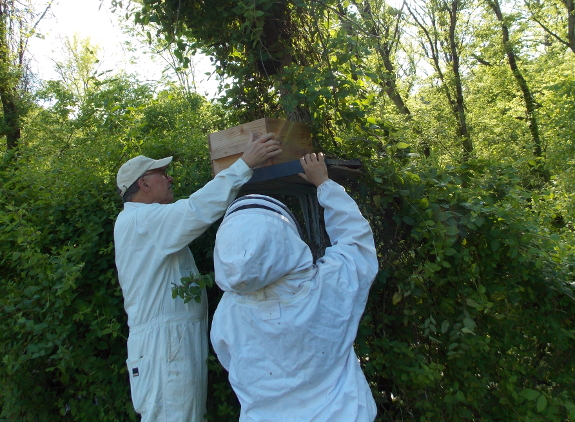
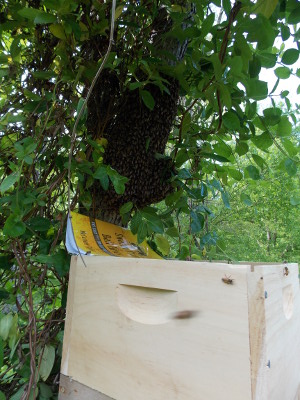 Nearly
as easily done as said! Too bad our hive was a cobbled-together
version of Langstroth and Warre equipment since we want the bees to
eventually live in the latter but have much more of the former on
hand.
It seemed to form a relatively solid container, though.
Nearly
as easily done as said! Too bad our hive was a cobbled-together
version of Langstroth and Warre equipment since we want the bees to
eventually live in the latter but have much more of the former on
hand.
It seemed to form a relatively solid container, though.
Unfortunately, the tree
grew at a bit of a slant, so there was a good
chance the bees would fall into the gap between the hive and the
trunk. Perhaps a bee book would make a good ramp to guide them in
the right direction?
Here's where activity
got heated and we stopped taking pictures (except
the last one below). Our neighbor and I suited up, I stood on a
bucket with a brush, and he stood on the ground with a hoe.
"On three, I'll yank
this vine and shake the bees into the hive, then
you start brushing any stragglers down," he ordered. "One, two,
THREE!"
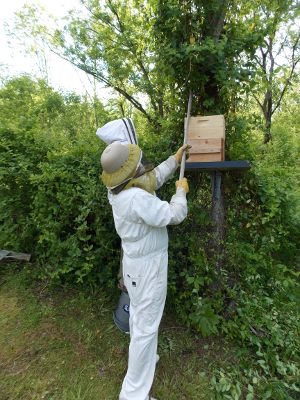 Whoosh!
Bees were everywhere! Even though bees in a swarm are supposed to
be very polite, I was ultra-glad I'd donned a bee suit since I'm
positive I'd otherwise have ended up with several ladies stuck in my
hair. I put on the lid, then we stepped back and waited.
Whoosh!
Bees were everywhere! Even though bees in a swarm are supposed to
be very polite, I was ultra-glad I'd donned a bee suit since I'm
positive I'd otherwise have ended up with several ladies stuck in my
hair. I put on the lid, then we stepped back and waited.
At first, we thought
we'd been successful, but when I checked on the
hive just before dark, the swarm had reformed in the narrow gap between
tree and box. I guess our bee book wasn't as good of a ramp as
I'd
thought and the queen fell into the gap, then everyone else
followed. Downhearted, I figured the experiment had been a
failure, but by the next morning, I'd figured out a solution.
Mark and I headed out to
the swarm first thing the next day and I
sprayed all the bees I could reach with sugar water. Then Mark
gently
eased the second box away from the tree, figuring at least some of the
bees would adhere to the surface and end up dangling above the cavity
below. Sure enough, his gentle motion combined with my brushing
got at least half of the swarm into the lower box, then we pushed the
hive back
together.
This time, I was sure
we'd failed since bees nearly immediately began clustering between the
box and the tree again. But a few hours
later, the bees were streaming into the hive box instead. I can
only guess
that, at first, that gap smelled like queen, but as her scent
dissipated, the workers discovered the queen herself, ensconced in her
new hive.
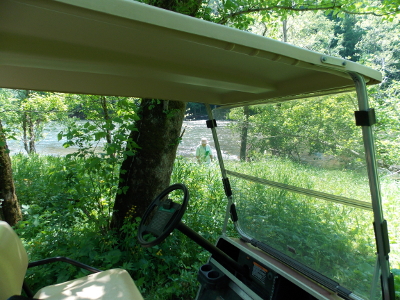 Unfortunately, this happy
sight was not the ending of the story. On our neighbor's
recommendation, we left the hive in place that afternoon so any
stragglers would join their queen, and I went off-farm to monitor the
quality of our nearby river. It was a blazingly
hot day, reaching nearly 90 in the shade, and perhaps the heat was too
much for the bees (or they really wanted to live in that site
two miles away). Because when I came home, the hive was empty,
the swarm gone.
Unfortunately, this happy
sight was not the ending of the story. On our neighbor's
recommendation, we left the hive in place that afternoon so any
stragglers would join their queen, and I went off-farm to monitor the
quality of our nearby river. It was a blazingly
hot day, reaching nearly 90 in the shade, and perhaps the heat was too
much for the bees (or they really wanted to live in that site
two miles away). Because when I came home, the hive was empty,
the swarm gone.
So, we didn't catch our
first swarm after all, but I did get a lot of hands-on experience and I
feel much more confident that I'll know what to do next time.
I'll probably move the hive to a good location right away if we catch
another swarm, and I should definitely get our ducks in a row so we
always have extra equipment on hand for swarm catching.
Of course, catching
swarms is always chancy, so we'll continue to experiment with setting
up swarm
traps, the sooner
the better. Honeybee
Democracy explains
that the scouts who go out looking for a new homesite are usually the
hive's oldest foragers, which suggests they may be househunting on the
sly for weeks before they leave their old home (meaning that a swarm
trap set up the day before a swarm emerges may be too late). And
even though I haven't read any data to this effect, I also wouldn't be
surprised if honeybees preferentially choose new house sites further
from their home colony, since they'd then have less competition for
resources and less chance of catching pests and diseases. Perhaps
bees would be most likely to move into a swarm trap at the parking
area, a third of a mile from our other hive?
Want more in-depth information? Browse through our books.
Or explore more posts by date or by subject.
About us: Anna Hess and Mark Hamilton spent over a decade living self-sufficiently in the mountains of Virginia before moving north to start over from scratch in the foothills of Ohio. They've experimented with permaculture, no-till gardening, trailersteading, home-based microbusinesses and much more, writing about their adventures in both blogs and books.
Want to be notified when new comments are posted on this page? Click on the RSS button after you add a comment to subscribe to the comment feed, or simply check the box beside "email replies to me" while writing your comment.

Wow that was exciting. Sorry the bees left, but everything you do with bees is a learning experience.
I mentioned yesterday that we had caught swarms from the same tree in the past. It's a cedar and they rested about 10 feet up on a limb each time. My hubby cut the limb right above where the swarm rested in each case. We caught the 1st swarm by shaking the bees from the limb onto a sheet. We had a hive with frames installed (included some older pulled frames to make them feel more at home) and the bees climbed in overnight. We closed up the hive and moved it the next morning. We caught a 2nd swarm by shaking the bees from the cut limb directly into the set up hive body (again with some old pulled frames). We still had the sheet under and left it on the ground to allow any lingering bees or bees that fell off to go into the hive. We moved that one the next morning as well. Both of these swarms came from our established hives and swarmed late in the day so it was pretty easy to just wait until dusk to catch the swarms. We used the sheet because my daughter was trying to find the queen to make sure she got into the hive since there wasn't much chance of the bees staying otherwise. She actually located and gently moved the queen into the hive the 1st time. Pretty sure that's when the easier shake them into the hive route the 2nd time. We haven't had problems with swarming recently, but I'm sure that's because it's hard to even keep bees in our area recently. Beekeepers in our area have had at least 50% losses coming out of winter this year. We just installed 2 packages over the weekend. Unfortunately we couldn't get bees any earlier. It's pretty late in our area to install, but I'm keeping my fingers crossed. I know we'll be feeding them, but they're busy bringing in pollen so I'm hopeful.
The Warre hive does look interesting and I may into that. It seems like less meddling with the bees would probably make them much happier. We're using Langstroth hives now, mainly because that's what others we know were using when we started. We'll might stick with that because there are so many others in our area using this method and it's easy to get equipment in a pinch from someone else when you're in a bind.
I love to read about the daily happenings at your homestead. Happy beekeeping!
Sorry your swarm moved on.
I am still a rookie at this but one thing that I have found that has helped me keep new packages and swarms from leaving is to give them a bar or two of comb to start on. If you steal a bar of brood from an existing hive and place it in that has worked even better. They don’t want to abandon the brood I guess. All of my horizontal top bar hives are the same for this reason. I can move things around as needed. This has been both a blessing and a curse. It is convenient but it has also prevented me from making modifications to new hives. I am thinking about making them a little wider but I will have to do all of them or my system will no longer work.
I enjoy reading your blog. I am amazed at how you are able to keep it updated so well. Something I am still trying to get better at with ours.
Ned http://www.newbyshomesteadhideawayfarm.com/
Hi, Anna--So involving, all that re-hiving of a swarm. Good you still have some left? And very curious about where they went...I wonder if they are over at the Lavender Farm?? For next time, maybe you will want to figure out how otheir swarm (which strikes me as spring house-cleaning) is connected to the last frost. You never had a swarm before? At least these bees were healthy enough to move on out! Looking forward to re-grouping, about the tomatoes:)